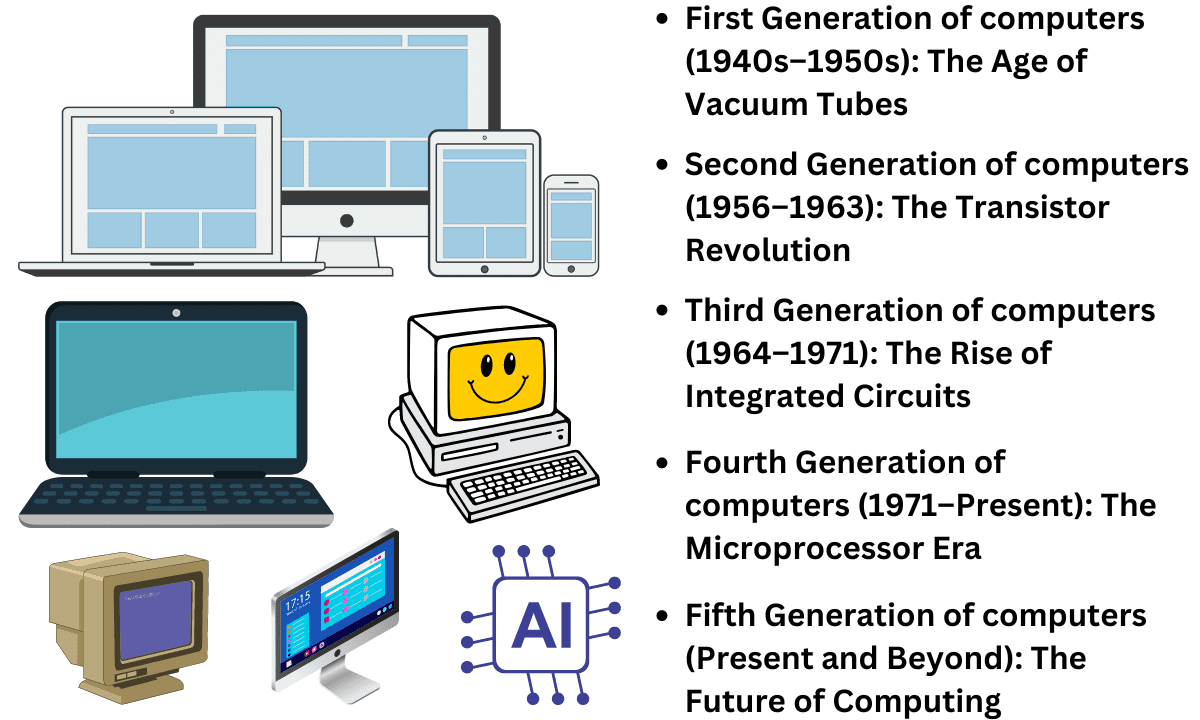Generation of computers: The history of computers is a fascinating narration of human brilliance and unwavering invention. Computers have evolved dramatically, from the massive, room-filling machines of the past to the sleek, ultra-portable ones we use today. To comprehend this progression, we investigate the idea of generations of computers.
Computer generations describe technological breakthroughs based on distinguishing characteristics, typically the underlying hardware components. Each generation marks a substantial advancement, resulting in reduced size, quicker processing, and improved capabilities. Let’s go further into each generation of computers and examine the major aspects that distinguish them.
First Generation of computers (1940s–1950s): The Age of Vacuum Tubes
The first generation of computers was born during the pioneering age of computers, which lasted from the 1940s to 1950s. These behemoths used massive vacuum tubes to process information. Vacuum tubes were delicate, produced enormous heat, and required a substantial amount of electricity.
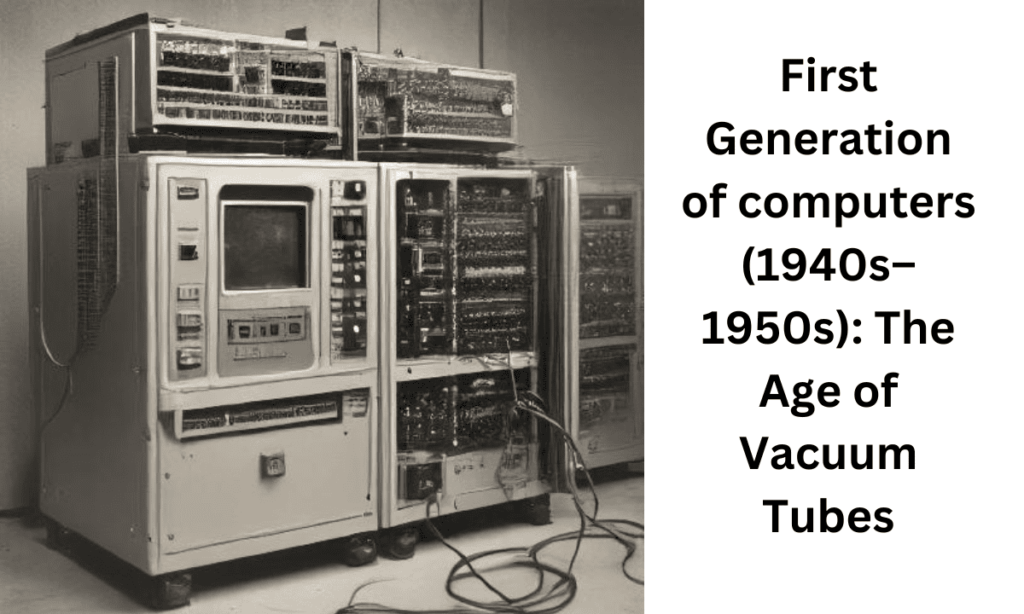
Important characteristics of first-generation computers:
- Vacuum tubes are the key technique for processing information.
- Punched cards and paper tape are used for input and output.
- Machine language is the only programming language accessible and requires a thorough grasp of computer architecture.
- Slow processing: calculations took a considerably longer time compared to modern computers.
- Limited memory: Magnetic drums and tapes were the principal storage technologies.
- Examples: ENIAC and UNIVAC.
Second Generation of computers (1956–1963): The Transistor Revolution
The creation of the transistor in 1947 represented a watershed moment in the history of computing. The second generation of computers replaced large vacuum tubes with transistors, ushering in a new age of smaller, quicker, and more dependable machines. Transistors were substantially smaller, produced less heat, and used less power than their predecessors.
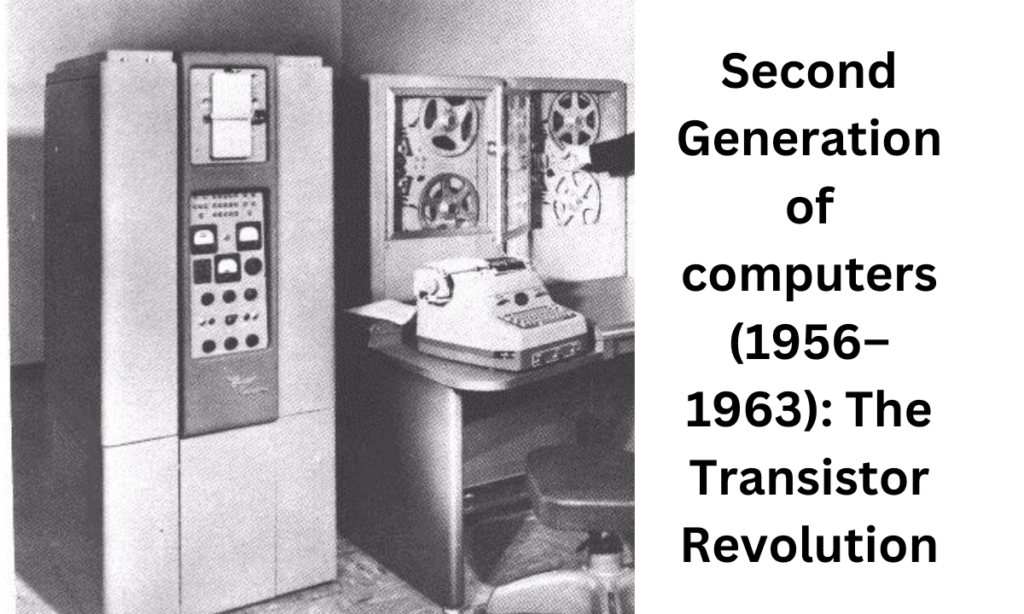
Important characteristics of second-generation computers:
- Transistors replaced vacuum tubes as the primary processing unit.
- Magnetic core memory provided quicker access times than magnetic drums and cassettes.
- Higher-level programming languages: The introduction of languages such as FORTRAN and COBOL made programming more accessible.
- Increased processing speed: Calculations got considerably faster than in the first generation.
- Examples: IBM 1401 and IBM 7090.
Third Generation of computers (1964–1971): The Rise of Integrated Circuits
The third generation of computers saw the creation of integrated circuits (ICs), sometimes known as microchips. These small chips mounted transistors, resistors, and other electronic components on a single silicon wafer. This shrinking resulted in a considerable decrease in size, higher processing speed, and increased computer dependability.
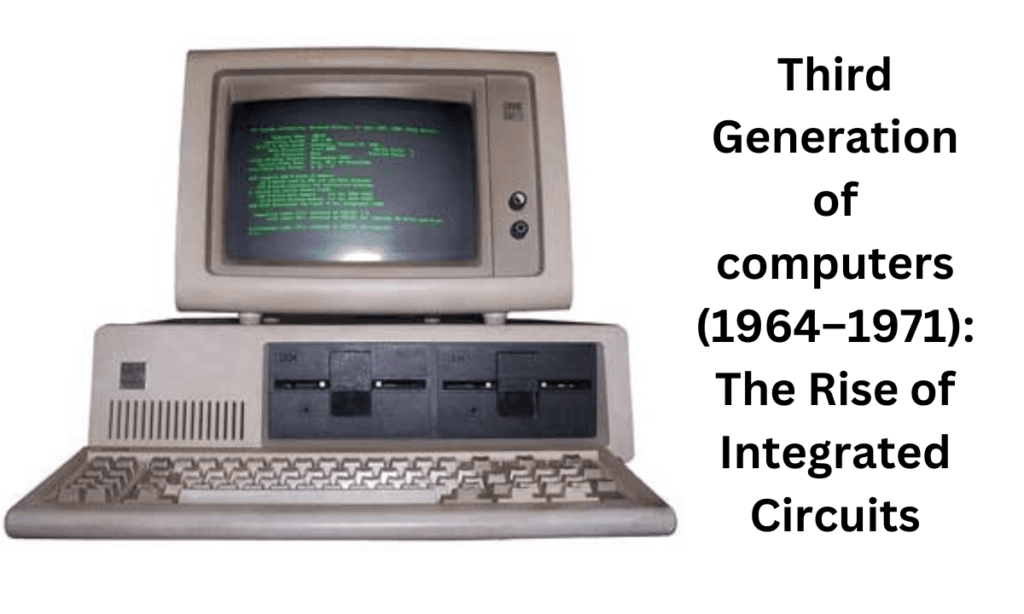
Important characteristics of third-generation computers:
- Integrated circuits: Transistors and other components were shrunk and integrated into a single chip.
- Operating systems were created to control hardware resources and give a user interface.
- Higher-level programming languages: Languages like as FORTRAN and COBOL continue to be developed, as do new languages such as Pascal and BASIC.
- Increased affordability: As technology improved, computers became more accessible to companies and organizations.
- Examples: IBM System/360 and PDP-8.
Fourth Generation of computers (1971–Present): The Microprocessor Era
The introduction of the microprocessor in 1971 signaled the start of the fourth generation of computers. A microprocessor consists of a single chip with a central processing unit (CPU). This additional shrinking transformed the computer industry, opening the path for personal computers.

Important characteristics of fourth-generation computers:
- Microprocessors: CPUs were merged into a single chip, resulting in tremendous downsizing.
- Personal computers (PCs) became available to individual users, resulting in broad use of computers.
- Graphical user interfaces (GUIs): Developed a user-friendly interface that included icons, windows, and menus.
- Increased processing power and memory: Computers become quicker and could handle more complicated jobs.
- Development of the internet: The internet enabled worldwide communication, information exchange, and cooperation.
- Examples: Apple II; IBM PC.
Fifth Generation of computers (Present and Beyond): The Future of Computing
The fifth generation of computers is a continuous development that focuses on artificial intelligence (AI) and advances in parallel computing. The objective is to construct intelligent robots capable of learning, reasoning, and problem solving in the same way as humans can.
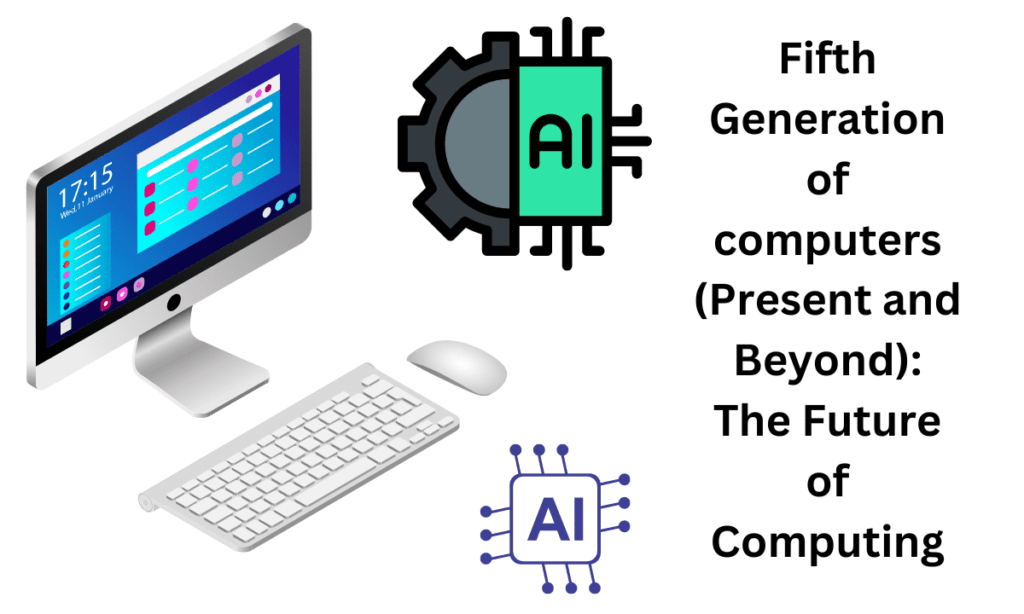
Important characteristics of fourth-generation computers:
- Artificial intelligence (AI) is the integration of AI algorithms that allow computers to learn and adapt.
- Natural language processing (NLP) enables computers to interpret and respond to human discourse.
- Parallel processing is the distribution of jobs over several processors to speed up computing
- Quantum computing is the use of quantum physics ideas to problems that traditional computers cannot solve.
- Biotechnology-inspired computing: Investigating the potential of biological systems to provide novel computer paradigms.
While the actual shape of the fifth generation of computers is yet unknown, it is obvious that the emphasis is on developing intelligent machines that can interact with the environment in a more natural and seamless manner.
The impact of generations of computers
The advancement of computers across generations has had a significant influence on all aspects of our life. Computers have revolutionized businesses and transformed communication and entertainment, making them an integral aspect of our lives.
Here are some of the important areas influenced by successive generations of computers:
- Business: Computers have simplified processes, enhanced data management, and eased communication inside and across enterprises.
- Education: Educational resources are now easily accessible online, and technology-assisted learning approaches have increased student involvement.
- Communication: The internet has transformed communication, allowing for immediate texting, video conferencing, and worldwide cooperation.
- Entertainment: Computers have enabled new types of entertainment, such as video games, streaming services, and online content creation.
- Science and research: Computers have evolved into strong scientific research instruments, allowing for complicated simulations, data analysis, and medicinal advances.
The Future of generations of computers
As we look at several generations of computers, it’s clear that the future contains amazing possibilities. The ongoing development of AI, quantum computing, and other new technologies will push the limits of what computers can do. We can expect progress in areas such as:
- Personalized computing refers to computers that respond to individual requirements and preferences.
- Ubiquitous computing refers to the seamless integration of computers into our everyday environments.
- Augmented reality (AR) and virtual reality (VR) are technologies that provide immersive experiences by combining the physical and digital worlds.
The evolution of computers over time demonstrates human creativity. As we move forward, it will be intriguing to see how these powerful computers continue to alter our environment and redefine technological possibilities.
Conclusion
Understanding computer generations gives significant insight into computing’s extraordinary evolution. From the cumbersome machines of the first generation to the intelligent machines of the future, the road has been one of constant invention and advancement. As we look to the future of computers, it’s crucial to recall the fundamental ideas that have led us this far.
If you like this “What is the Generation of computers? (1st To 5th)” article, please share it with your friends. For more updates, keep an eye on: www.headlineocean.com

